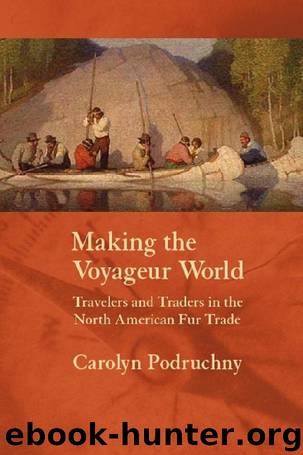Carolyn Podruchny - Making the Voyageur World Travelers and Traders in the North American Fur Trade by Podruchny Carolyn

Author:Podruchny, Carolyn. [Podruchny, Carolyn.]
Language: eng
Format: epub
Published: 2006-10-09T14:43:04+00:00
Upper Red River
Lower Red River
Lake Winnipic [Winnipeg]
Lac La Pluie
FondduLac 128
Departments
208 48 84 37 12 15 75 40 63 25 7 10
136
45
56
75
88
46
59 103 22 18 52 82 40 60 11 15 10 10 29 50 20 20
Nipigon
Kaministiquia and Mille Lac
and Lac des Chiens
LePic
nwc totals
AKCo.,men&c[oldxyc] 520 37 31 7 Overall totals 1610 405 600 25
90
16 36 16 2 3
62
13 1090 368 569 34
276 | tender ties
Henry determined the racial categorization of people by the “head of the household,” so “White” wives and children “belonged” to the traders.105 As- suming that all the “White” women were domestically involved with traders, an average of 25 percent of the combined officers and voyageurs had Aboriginal wives. This census also shows that partnerships with Aborigi- nal women were widespread throughout the Northwest. Jennifer Brown has argued that relationship rates between voyageurs and Aboriginal women were higher than those of laborers working for the hbc because the Mon- treal fur trade officers had less control over their men and could not prevent them from forming relationships with Aboriginal women.106 Voyageurs had much more contact with Aboriginal women than did other fur trade labor- ers and thus had different attitudes toward them. Sylvia Van Kirk has convincingly portrayed the importance of Aboriginal wives to traders:
The economic role played by Indian women in fur-trade society re- flected the extent to which the European traders were compelled to adapt to the native way of life. The all-encompassing work role of Indian women was transferred, in modified form, to the trading post, where their skills not only facilitated the traders’ survival in the wilderness but actual fur-trade operations. At the North West Company posts and at Hudson’s Bay Company posts especially, na- tive women came to be relied upon as an integral if unofficial part of the labour force. Their economic assistance was a powerful incentive for the traders to take Indian wives; even within their own tribes, the women exercised a role in the functioning of the trade which has been little appreciated by historians of this period.
Van Kirk describes Aboriginal wives supplying the traders with moccasins and snowshoes, dressing skins, helping in canoe construction and pad- dling, preparing food such as pemmican, curing and drying meat and fish, collecting rice and berries, and trapping small game.107 The wives of voya- geurs worked alongside their husbands, helping them with chores ranging from food procurement to trapping and dressing furs to cultivating trad- ing contacts. Aboriginal wives helped their husbands make sugar from ma-
ple trees, gather wildfowl eggs, transport meat to the post from kill sites, fish, and attend to traps.108
Susan Sleeper-Smith has demonstrated that women played another role equally important in the fur trade. Those Aboriginal women who married French traders in the southern Great Lakes area in the early eighteenth cen- tury established elaborate kinship networks within fur trade families and connected to Aboriginal societies. These kin networks became crucially important for the successful functioning of the trade. She explains that “marital and kinship strategies transformed trade into a social process and medi-ated the disruptions inherent in disparate and competing economic systems.
Download
This site does not store any files on its server. We only index and link to content provided by other sites. Please contact the content providers to delete copyright contents if any and email us, we'll remove relevant links or contents immediately.
| Africa | Americas |
| Arctic & Antarctica | Asia |
| Australia & Oceania | Europe |
| Middle East | Russia |
| United States | World |
| Ancient Civilizations | Military |
| Historical Study & Educational Resources |
Life Stages and Native Women by Kim Anderson(402)
Canada's Residential Schools by Truth and Reconciliation Commission of Canada(327)
Carolyn Podruchny - Making the Voyageur World Travelers and Traders in the North American Fur Trade by Podruchny Carolyn(291)
First Nations? Second Thoughts by Tom Flanagan(180)
